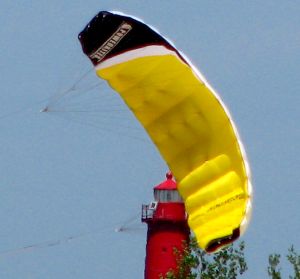Buying a Trainer kite
Buying a Trainer Kite
| Trainer Kite | HQ Fluxx | Rush IV 200 | Hydra 300 | Rush V Pro 350 | HQ Scout2 4.0 | HQ Scout2 5.0 |
| 2-line Kite | ||||||
| 3 or 4-line Kite | ||||||
| Power | ||||||
| Safety Leash | ||||||
| Harness Loop | ||||||
| Colored Lines | ||||||
| DVD | ||||||
| Kite Size | 1.8 m² | 2 m² | 3.5 m² | 3.5 m² | 4 m² | 5 m² |
| Wind Range | 5-28 mph | 6-29 mph | 4-21 mph | 4-29 mph | 4-31 mph | 4-27 mph |
| Kite Uses | Trainer, Snow/Land | Trainer | Trainer, Water | Trainer | Trainer, Snow/Land | Trainer, Snow/Land |
| Price | $75.99 | $99 | $313.49 | $275.49 | $389.49 | $427.49 |
![]() = No pull
= No pull![]()
![]() = May tug, but no pull
= May tug, but no pull![]()
![]()
![]() = Pulls you around pretty good
= Pulls you around pretty good
2 Line vs 4 Line Trainer kites come in either 2 or 3/4 line styles. Typically the smaller kites come with just 2 lines and the more powerful kites (over 3m) come with 3 or 4 lines. In terms of flying, a 2-line kite flies just as well as a 3 or 4-line. The benefit of a 2-line kite is that the lines never really get tangled, where the benefit of a 3 or 4-line kite is the ability to relaunch the kite after it crashes. (To relaunch a 2-line kite you'll need to walk back to the kite and put it in the correct position - see How to Fly a Trainer Kite.)
Trainer kites come in either 2 or 3/4 line styles. Typically the smaller kites come with just 2 lines and the more powerful kites (over 3m) come with 3 or 4 lines. In terms of flying, a 2-line kite flies just as well as a 3 or 4-line. The benefit of a 2-line kite is that the lines never really get tangled, where the benefit of a 3 or 4-line kite is the ability to relaunch the kite after it crashes. (To relaunch a 2-line kite you'll need to walk back to the kite and put it in the correct position - see How to Fly a Trainer Kite.)
Size
Trainer kites typically range in size from 1m to 5m. The bigger the trainer kite, the more powerful it is. Larger kites (3m and up) fly very smoothly and feel more like a kiteboard kite compared to the fast-turning and zippy small kites. One small movement on the bar with a 1.8 m² Symphony will send the kite looping in circles.
Larger kites which have more power can pull you around a bit and can provide you with even more training. If you are a smaller person (or if it is really windy), you may be able to use the trainer kite in the water for body dragging or in the winter for snowkiting. Typically people who buy a large trainer kite end up getting more use out of it than if they bought a 1m or 2m kite.
 Harness Loop
Harness Loop
Some trainer kites like the HQ Scout come with a harness loop. This is essentially a loop that goes on the bar so you can fly the kite while wearing a harness. Buying a kiteboard harness progresses your training even further by being able to fly hooked in. Flying 'hooked in' gets your body and arms in the correct positioning. Many times you'll see people flying a trainer kite and they'll pull the bar over their head instead of the proper position of the bar near the waist. Being hooked in also enables you to fly one-handed which is a must in kiteboarding. If you're planning on getting into kiteboarding, you'll need a harness eventually, so if you're serious about getting into the sport, you're better off buying it when you purchase a trainer kite.
Safety
Some kites come with a type of wrist leash. With a leash, when you let go of the bar, the kite will drop to the ground, but it will still be attached to you. Without a leash, once you let go of the bar, the kite might travel further downwind and you'll have to chase it down the beach.
Conclusion
Overall, you can't go wrong with purchasing a trainer kite. Whether you're looking at a 1.8 m² Symphony or 5 m² Scout, you'll still be much better off than someone whose only trainer kite experience was in their lesson. You can never spend too much time with a trainer kite.
Suggested Reading:
- How to Fly a Trainer Kite
- Kiteboarding FAQs
- Getting Started: First Steps
- Kiteboarding Tips
Continue to 'Types of Kiteboarding Gear'
Return to the Kiteboarding Knowledge Center
